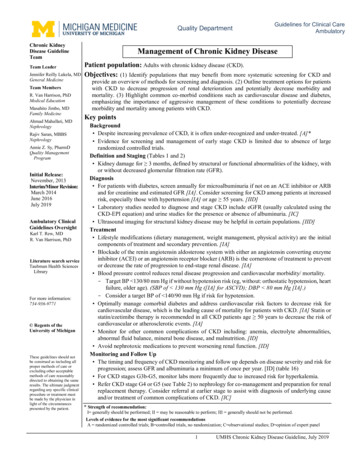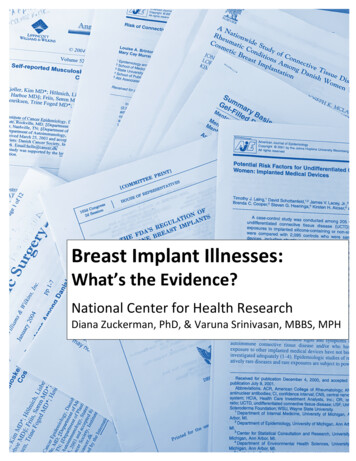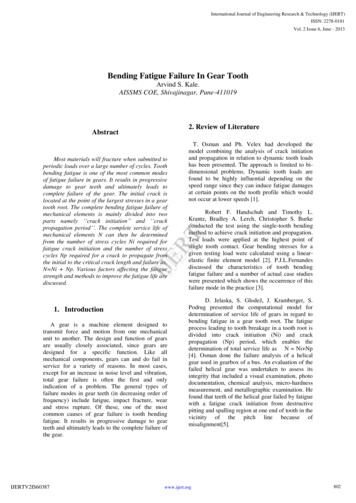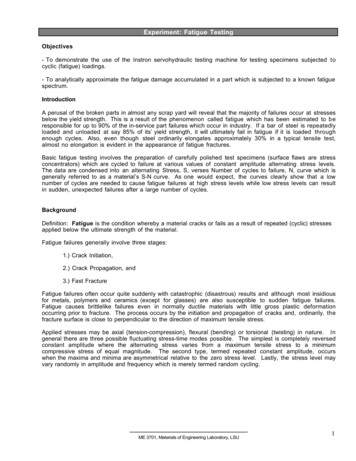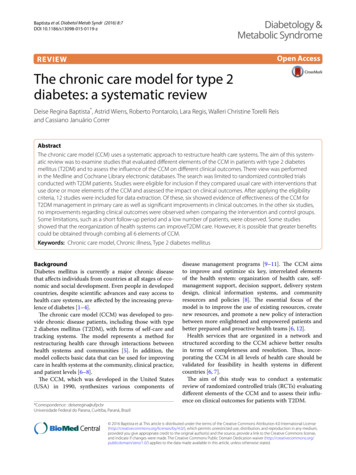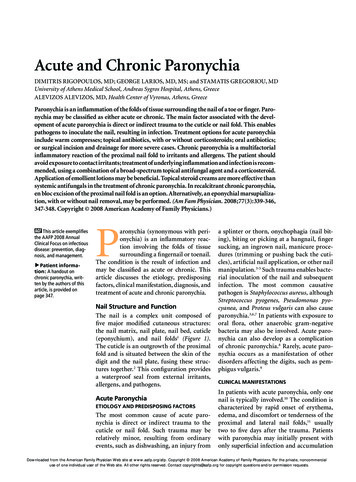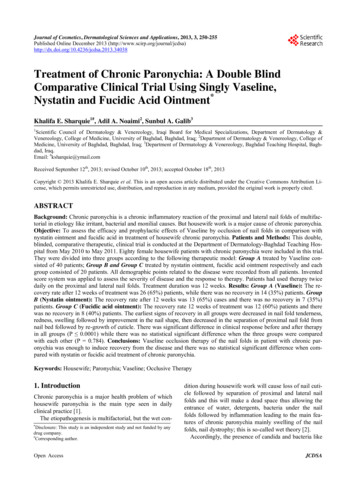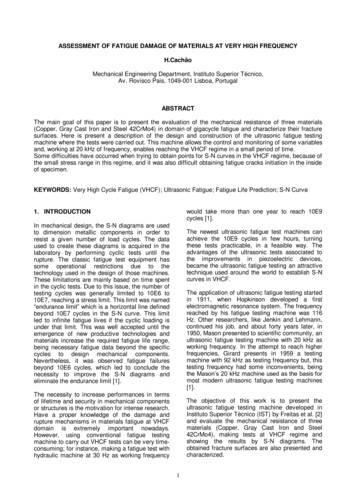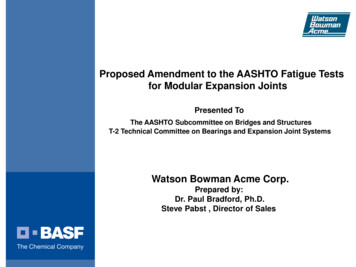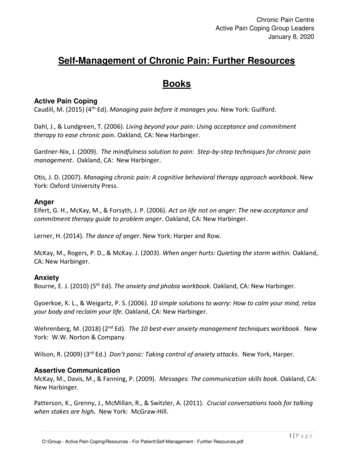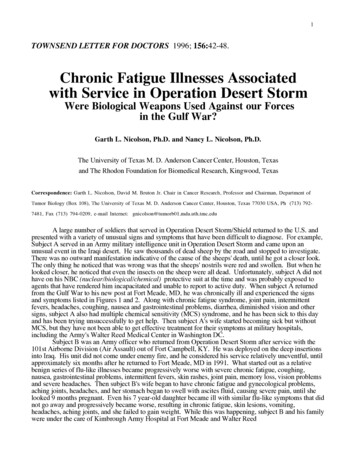
Transcription
1TOWNSEND LETTER FOR DOCTORS 1996; 156:42-48.Chronic Fatigue Illnesses Associatedwith Service in Operation Desert StormWere Biological Weapons Used Against our Forcesin the Gulf War?Garth L. Nicolson, Ph.D. and Nancy L. Nicolson, Ph.D.The University of Texas M. D. Anderson Cancer Center, Houston, Texasand The Rhodon Foundation for Biomedical Research, Kingwood, TexasCorrespondence: Garth L. Nicolson, David M. Bruton Jr. Chair in Cancer Research, Professor and Chairman, Department ofTumor Biology (Box 108), The University of Texas M. D. Anderson Cancer Center, Houston, Texas 77030 USA, Ph (713) 7927481, Fax (713) 794-0209, e-mail Internet: gnicolson@tumorb01.mda.uth.tmc.eduA large number of soldiers that served in Operation Desert Storm/Shield returned to the U.S. andpresented with a variety of unusual signs and symptoms that have been difficult to diagnose. For example,Subject A served in an Army military intelligence unit in Operation Desert Storm and came upon anunusual event in the Iraqi desert. He saw thousands of dead sheep by the road and stopped to investigate.There was no outward manifestation indicative of the cause of the sheeps' death, until he got a closer look.The only thing he noticed that was wrong was that the sheeps' nostrils were red and swollen. But when helooked closer, he noticed that even the insects on the sheep were all dead. Unfortunately, subject A did nothave on his NBC (nuclear/biological/chemical) protective suit at the time and was probably exposed toagents that have rendered him incapacitated and unable to report to active duty. When subject A returnedfrom the Gulf War to his new post at Fort Meade, MD, he was chronically ill and experienced the signsand symptoms listed in Figures 1 and 2. Along with chronic fatigue syndrome, joint pain, intermittentfevers, headaches, coughing, nausea and gastrointestinal problems, diarrhea, diminished vision and othersigns, subject A also had multiple chemical sensitivity (MCS) syndrome, and he has been sick to this dayand has been trying unsuccessfully to get help. Then subject A's wife started becoming sick but withoutMCS, but they have not been able to get effective treatment for their symptoms at military hospitals,including the Army's Walter Reed Medical Center in Washington DC.Subject B was an Army officer who returned from Operation Desert Storm after service with the101st Airborne Division (Air Assault) out of Fort Campbell, KY. He was deployed on the deep insertionsinto Iraq. His unit did not come under enemy fire, and he considered his service relatively uneventful, untilapproximately six months after he returned to Fort Meade, MD in 1991. What started out as a relativebenign series of flu-like illnesses became progressively worse with severe chronic fatigue, coughing,nausea, gastrointestinal problems, intermittent fevers, skin rashes, joint pain, memory loss, vision problemsand severe headaches. Then subject B's wife began to have chronic fatigue and gynecological problems,aching joints, headaches, and her stomach began to swell with ascites fluid, causing severe pain, until shelooked 9 months pregnant. Even his 7 year-old daughter became ill with similar flu-like symptoms that didnot go away and progressively became worse, resulting in chronic fatigue, skin lesions, vomiting,headaches, aching joints, and she failed to gain weight. While this was happening, subject B and his familywere under the care of Kimbrough Army Hospital at Fort Meade and Walter Reed1
2Chronic Symptoms Reported in Different National Guard orReserve Units Deployed versus Not Deployed to the Persian GulfUnit AUnit B4.0Joint PainChronic FatigueMemory LossSleep DifficultiesHeadachesSkin RashesJoint 31.75.32.7GastrointestinalDiarrheaSinus Congest.Speaking Prob.12.51.63.5DeployedNotDeployed1.62.2204060 0%204060% Prevalence Rates (Ratios)% Prevalence Rates (Ratios)0%Figure 1. Control study on Persian Gulf War illnesses conducted by the CDC. The bars indicate thefrequencies of common symptoms in deployed (solid bars) and non-deployed (stippled bars) members of aAir Guard (Unit A) and Air Force Reserve (Unit B) units that approximately equal numbers of airmendeployed or not deployed to the Persian Gulf Theater of Operations.Army Medical Center. They never received a diagnosis, explanation or treatment for their illnesses, evenafter extensive testing. Later they found out that several families of Gulf War veterans at Fort Meade hadsimilar health problems and nowhere to go for help. These families were being told that they hadpsychological problems, but they claim and can prove with documentation that they are sick and deserveproper treatment.Subject C was an Air Force Special Operations intelligence officer attached to the 5th SpecialForces Group based at King Fahd Airport west of Dhahran and the 160th Special Operations AviationRegiment at King Khalid Military City. He was involved in the Special Forces operations, but remained inSaudi during the war. However, the area where was stationed was under constant SCUD missile attackduring the war. After his return to the U.S., he noticed that he had a constant sore throat, night sweats,shortness of breath, dizziness, joint pain, short term memory loss, vision problems, diarrhea and otherbowel problems, skin rashes and severe to moderate chronic fatigue. He eventually left the military and hasnot been able to obtain appropriate treatment from VA hospitals for his illness.Another Special Forces officer now in DELTA ONE (Delta Force) at Fort Bragg was subject D, aNavy officer in charge of the SEAL units that were involved in some of the most sensitive covert missionsduring Operation Desert Storm. He presented after the Gulf War with chronic fatigue, fever, stomachcramps, joint pain, skin rashes, memory loss, dehydration, headaches and heart pain and other symptomsshown in Figure 2. His vision became so diminished that physicians at Womack Army Hospital wereconsidering surgery. He stated to us that he had "every conceivable test conducted, treatments, etc., knownto the military with zero results, zero answers and zero relief."Although most military, VA, and civilian doctors agree that these Gulf War veterans have medicalproblems, they have been unable to diagnose the exact syndrome. This has resulted in the misinformationthat the Desert Storm veterans do not have health problems. That they do have undiagnosed medicalconditions was carefully shown in a control study by the Center for Disease Control (CDC) in Atlanta.1The CDC epidemiologists studied hundreds of airmen from an Air National Guard unit from Pennsylvaniathat were deployed to the Persian Gulf and compared their health problems to similar numbers of members2
30%20406080100%Aching JointsChronic FatigueMemory LossNight SweatsHeadachesSkin RashesConcentration LossDepressionMuscle SpasmsNervousnessDiarrheaBlurred VisionAnxietyBreathing ProblemsChest PainDizzinessNauseaStomach PainOther Vision ProblemsLight SensitivityGWSCFIDSLoss of BalanceHivesSex ProblemsUrination ProblemsHair LossChemical SensitivitiesFrequent CoughingBleeding GumsEye RednessEye Pain0%20406080100%Percentage Symptoms of GWS versus CFIDSFigure 2. Comparison of symptoms in approximately 650 Desert Storm veterans suffering from DesertStorm Illness with symptoms of CFIDS (From Nicolson and Nicolson2 ).3
4of the same unit that were not deployed (Figure 1). They also studied Air Force reserve and active dutyunits in Pennsylvania and Florida. In these four units the deployed members had a variety of chronicillness symptoms that were not present in the same frequencies in the undeployed members of the sameunits.1 Even with this controlled study, some military and VA physicians still don't even believe that GulfWar Syndrome (GWS) exists, and they do almost nothing to treat the illnesses associated with OperationDesert Storm.Approximately 50,000-100,000 Desert Shield/Storm veterans, and in many cases their familymembers, share similar but individually unique sets of signs and symptoms (see Figure 2)2 that cannot beeasily explained. Since collectively these signs and symptoms are not well established as criteria forparticular diseases and they do not readily fit into common diagnosis categories used by military and VAhospitals, many physicians simply list the diagnosis as unknown, or worse, they conclude that their patientshave psychological problems, such as Post Traumatic Stress Disorder [PTSD].Most military personnel that we interviewed were particularly disdainful of a "psychologicalexplanation" for GWS. We have been told repeatedly by veteran combat soldiers that the Desert Stormconflict was not particularly stressful as far as wars go. Indeed, the involvement of multiple organ systemsand multiple, seemly disparate signs and symptoms of GWS have baffled most physicians and have notallowed them place patients into a single working case definition that would enable them to get appropriatetreatment. Using PTSD and other psychological profiles for GWS seems like a convenient cover to mostGulf War veterans. In fact, the signs and symptoms of GWS amost exactly fit the profile for ChronicFatigue-Immune Dysfunction Syndrome (CFIDS).2 Thus the DoD is probably correct in their stance thatGWS is not a new syndrome, and from the signs and symptoms we believe that it is a CFIDS-likedisorder.2 Even Major General Ronald Blanck, commanding officer of Walter Reed Army Medical Centerin Washington D.C., agrees that GWS "symptoms list fit a CFIDS-like illness." 3The classical working case definition of CFIDS was proposed by the CDC. CFIDS ischaracterized by persistent or relapsing, debilitating fatigue or easy fatigability in a person who has noprevious history of similar symptoms, that does not resolve with rest and is severe enough to reduce orimpair average daily activity below 50% of the patient's premorbid activity level.4 In addition to the absenceof clinical conditions that could easily explain the symptoms, such as cancers or autoimmune diseases,patients present with mild fever, sore throat, muscle pain, generalized muscle weakness, headaches, painfullymph nodes, sleep difficulties, and neuropsychologic complaints, such as memory loss, light sensitivity,confusion, irritability and depression.4 These signs and symptoms closely parallel those found in GWS(Figure 2).2 Thus GWS is not a separate syndrome; it appears to be a CFIDS-like disorder as weproposed previously.2Some of the Desert Shield/Storm veterans that have multiple chronic symptoms may eventuallyhave their diagnoses linked to chemical exposures in the Persian Gulf, such as oil spills and fires, smokefrom military operations, chemicals on clothing, pesticides, chemoprophylactic agents, chemical weaponsand others. In some cases, this exposure may have resulted in multiple chemical sensitivity or MCS, suchas seen in subject A. MCS shares some but not all of the symptoms listed in Figures 1 and 2, includingimmune system dysfunction,5 but in many of the soldiers the infectious nature of the illnesses and thespread of the illness to immediate family members precluded simple explanations, such as exposure totoxic chemicals that were present at some Gulf locations or exposure to Iraqi chemical weapons. In thesepatients, the chronic symptoms and moderately contagious nature of the illness are consistant with chronicinfections that can cause CFIDS-like symptoms.2The medical problems experienced by many Desert Storm veterans, and in some cases theirimmediate family members, is one of the ongoing mysteries of the Gulf War. In an attempt to answercriticisms that the DoD and VA were not taking these problems seriously Gulf War Registration Units andDesert Storm Referral Centers were established by the Dept. of Veterans' Affairs to document healthcomplaints. Next, a Technology Assessment Workshop was organized by the National Institutes of Health(NIH) with the task of examining information and reports on Gulf War Illnesses, recommending workingcase definitions for these illnesses, developing plausible etiologies and biological explanations for theillnesses, and finally recommending future research efforts to understand, diagnose and treat the illnesses.6In fact, some of the aforementioned tasks, such as the establishment of initial workshops and ReferralCenters at VA hospitals were accomplished.4
5Unfortunately, the lack of any concrete results and, for the most part, the lack of significantprogress in assigning diagnoses and initiating effective treatments for veterans and their families for theirGulf War illnesses have not received appropriate priority, even with the political pressure of variousveterans organizations. Also, the politicians in Washington do not seem to be very interested in this issue.Even worse have been the catagoric statements of some officials, such as John Deutch, then DeputySecretary of Defense, that chemical or biological weapons were not used during Desert Storm, effectivelyeliminating these important sources of the illnesses from careful consideration by military and VAhospitals.In 1994 a national panel was convened to discuss the medical problems of Gulf War veterans. TheNIH Technology Assessment Panel issued a Workshop Report on Desert Storm Illnesses6 that was meantto address fears that these illnesses were not being taken seriously and to establish practical working casedefinitions for the chronic illnesses associated with Operation Desert Storm. Unfortunately, the WorkshopReport issued by the Technology Assessment Panel6 did little to address the Gulf War veterans' and theirfamilies charges that next to nothing was being done to help them. Earlier this year the Institute ofMedicine (IOM) of the National Academy of Sciences criticized the government's efforts as "intrinsicallyunsuitable for systematic study of the health effects of the Gulf War." While several departments (DoD,Veterans Affairs, Health and Human Services) are arguing over appropriate clinical studies and bettercoordination, tens of thousands of Persian Gulf War veterans remain chronically ill without much help fortheir plight.Even worse, there has been little attempt until recently to enlist medical and scientific specialists tohelp in this problem. In addition, up to 1995 there had not been any appropriation of funds to conductproper research into the possible causes or potential treatments of GWS. Previous attempts atappropriating funds for research on Gulf War illnesses were blocked by DoD, because they claimed thatthey duplicated ongoing DoD efforts. This policy has changed recently, however, and the DoD and theDepartment of the Army have set aside 4 million for Gulf War Illness studies to be awarded late in 1995or early in 1996.In their frustration, Gulf War veterans representing all 50 states met March 10-12, 1995 at a UnityConference of Gulf War veterans organizations in Dallas under the direction of Air Force reserve Maj.Denise Nichols, R.N. to exchange, discuss and disseminate information on patient registration, medical andemployment assistance, legislation, and medical/scientific issues of importance to Gulf War veterans. Oneof us (G.L.N.) was asked to chair the Medical Panel where environmental, chemical and biological sourcesof GWS were considered. Indeed, an important conclusion of this panel which was similar to other panelswas that there appeared to be no single cause or source for the collection of illnesses called GWS or DesertStorm Illness.7 Patients seem to fall into several categories, some with only MCS, some with chronicfatigue syndrome (CFIDS) without MCS, some with only a few of the symptoms listed in Figure 2, andsome with most if not all of the symptoms in the figure.7One of the first things that the panel did was dismiss a psychological origin of Gulf War Illnesses.Not that psychological problems did not exist among the soldiers in Desert Storm, but after carefulassessment of the symptoms of the overwhelming majority of Gulf War veterans, the symptoms did not fitwith a psychological origin of the diseases.7 Parasites such as Leishmaniasis and bacteria such asCholera are endemic to the Middle East and could be the cause for symptoms in at least some of thesoldiers with GWS; however, diagnostic tests are available for many of these agents, and there have been noreports that they are the causes for symptoms in a large number of patients with GWS. In some cases theexplanation has been attributed to known parasitic diseases, such as infections by Leishmania tropica,probably spread by a sandfly. This can result in viscerotropic leishmaniasis.8 However, many of thecommon symptoms of GWS do not fit with this explanation, and diagnosis of leishmaniasis is uncommonin Gulf War veterans. Nonetheless, it is unclear how prevalent leishmaniasis infections are in GWSpatients.A member of the panel at the meeting in Dallas,7 William Rea, M.D., Director of the EnvironmentalHealth Institute in Dallas, has been treating Desert Storm veterans with GWS and MCS. Similar to manynonveteran MCS patients, Desert Storm veterans with MCS responded to pollutant avoidance, vitamin andnutrient supplementation, allergin tolerization and physical therapy.9 This subset of GWS patients showedmarked imporvement in their MCS symptoms after such combination therapy.5
6MCS in Desert Strom veterans could have been the result of environmental exposure to chemicalsin the air or by direct contact or the use of chemical weapons. Many units reported the use of chemicalweapons in Desert Storm. Most of these reports have been abruptly dismissed by the DoD, but the authorsof this article find it difficult to dismiss the rather large number of these reports, and most importantly, thenumber of individual testimonies that indicate that many soldiers had immediate, classic symptoms ofchemical attacks while the NBC alarms were sounding. These are also documented in the logs of units thatserved in Persian Gulf. We feel strongly that the use of chemical weapons by Iraqi forces cannot bedismissed. In testamony to the U.S. Senate Banking Committee chaired by Senator Reagle, representativesfrom the Army's chemical warfare command indicated that over 14,000 chemical weapon alarms soundedduring Operation Desert Storm, and some soldiers in NBC units received medals for identifying the typesof chemical weapons that were used. In addition, the widespread use of experimental drugs and vaccinesagainst chemical and biological weapons have to be questioned, because if contaminated with infectiousagents, these can cause some of the signs shown in Figure 2.Some soldiers were probably exposed to chronic toxic environmental conditions during DesertShield and Desert Storm that can produce some of the signs listed in Figure 2, such as chronic coughingand pneumonitis. Continuous exposure to fine sand particles ( 1 mm diameter) can result in hyperergiclung conditions, and in more severe cases pneumonitis. This disease was first reported by AndreásKorényi-Both and his collaborators.1 0 Dr. Korényi-Both was the Commanding Officer of the Army's316th Station Hospital in Desert Storm and has been examining the enhalation of very small sand particlesthat produce what he has called Al Eskan Disease, a pneumonitis that causes flu-like symptoms andeventually immunodepression that can result in opportunistic infections.7 Environmental stress andinfections can result in the activation of endogenous human viruses. Dr. Howard Urnovitz of the CalypteBiomedical Corporation in Berkeley discussed his findings that up to 85% of veterans (and their families)with GWS have antibodies to certain human viruses in their urine.7 These viruses are human endogenousretroviruses (HERVs), and they are associated with a variety of autoimmune disorders.11 The the highfrequency of HERV activation in GWS may be symptomatic of exposure to chemi
Eye Redness Eye Pain Nervousness 0% 20 40 60 80 100% GWS CFIDS Percentage Symptoms of GWS versus CFIDS Figure 2. Comparison of symptoms in approximately 650 Desert Storm veterans suffering from Desert Storm Illness with symptoms of CFIDS (From Nicolson and Nicolson2). 4 4 of the same unit that were not deployed (Figure 1). They also studied Air .
